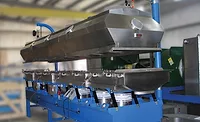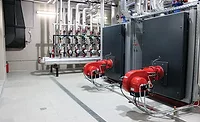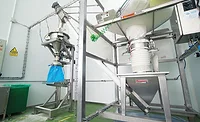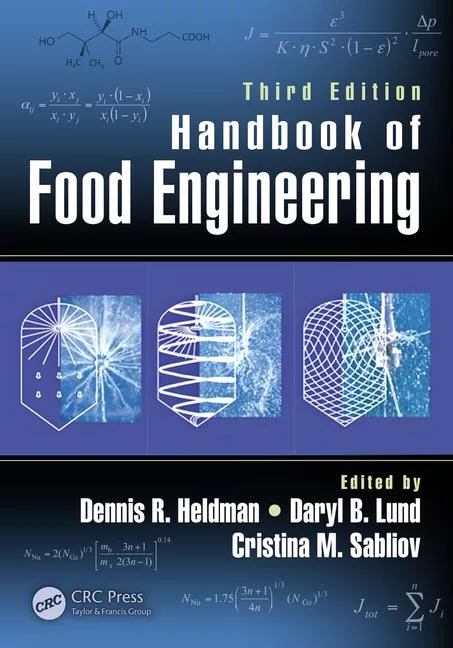Tech Update
Filling machines offer improved speed, sanitation and efficiency

TRU Aseptics, a Beloit, Wis.-based aseptic processor and packager, utilizes an Alfa Laval Bag in Box filler to offer its customers flexibility in the size of their product runs.
Photo courtesy of TRU Aseptics
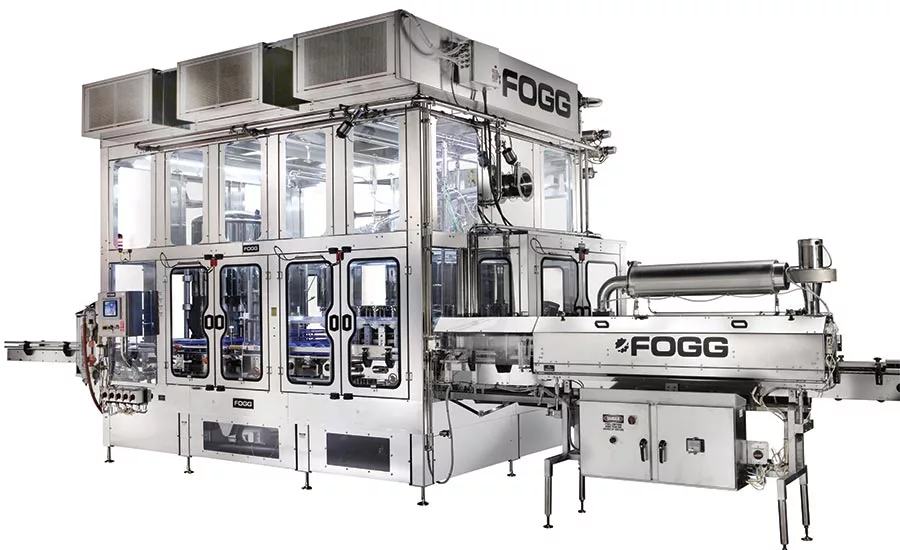
Processors are continuously looking for ways to cut down on changeover and cleaning time. Fogg Filler incorporates time-savers such as covers and components that can be removed by hand instead of requiring tools.
Photo courtesy of Fogg Filler

As processors look for more efficiency and easier cleaning, fillers are being built with more open spaces and fewer fasteners to make it easier to change over or clean machinery.
Photo courtesy of Spee-Dee

Automation of production lines, including fillers, offers processors more efficiency, better error checking and the ability to use production data to improve their processes.
Photo courtesy of Spee-Dee
Across the food industry, consumer demands, corporate requirements and safety guidelines are giving processors headaches as they try to figure out how to do things faster, cheaper and safer.
As processors wrestle with these challenges, every step of the production process and the supply chain is under scrutiny. Filling equipment is not exempt from that scrutiny, and as processors demand more efficiency and flexibility, manufacturers are working to offer equipment that helps meet those goals.
Compounding all of these challenges is the increased focus on organic, specialty and craft products. As they are often smaller runs, they add another layer of complexity to what processors need from equipment and how quickly they need to be able to adapt to producing different products.
At TRU Aseptics, a Beloit, WI-based company that offers aseptic processing and packaging, a shift in what the market was asking for led to an opportunity to offer some specialized services, says James Hurley, CEO, TRU Aseptics.
“The biggest unmet need we saw in the market was a growing level of small to medium-size volume requirements,” such as specialty or test runs, says Hurley.
To meet this need, TRU Aseptics turned to Alfa Laval for a high-speed bag-in-box filler. What makes this particular filler unique is that it can use IDC’s The Answer aseptic tap, which can dispense liquids from a BIB while maintaining stability. TRU Aseptics was the first company in North America to be able to use the tap, which gives the company the ability to offer processing and packaging solutions that other companies can’t.
With the ability to offer specialized solutions, such as those using The Answer tap, TRU has found success by having more smaller clients as opposed to a fewer large clients. Processors that usually work on a large scale often run into challenges when they try to scale down for a specialty run or a test market run, which is where TRU comes in.
“There are a lot of companies that are just trying to go to market or a test market, and they just don’t want to do it on lab equipment,” says Hurley. “They want a commercial version of a product to do a test market on.”
What TRU has found in its business is the same thing as the rest of the food industry: As production schedules get tighter, and mass production isn’t always the solution, flexibility, efficiency and safety are non-negotiable. To meet those requirements, filling machine companies are offering processors more of all of those things.
Speed kills
Timm Johnson, vice president of sales and marketing for Spee-Dee, has a pretty simple way to sum up what processors need from their equipment.
“They do not want your machine to stop their line,” he says.
There are a number of different ways that filling equipment could stop the line, and manufacturers are adapting to limit the chances of that happening. Quick changeover and clean-in-place solutions are both becoming more common and can help cut downtime and transition time between products.
There’s no way around the fact that speed is expensive, and processors have to understand that. But the other side of the coin is that if your filling machine can fill more packages in a shorter period of time, while still maintaining a high accuracy rate, then the extra cost can be absorbed pretty quickly.
“If people can go five bags a minute faster, the payback is pretty quick,” says Johnson.
At METTLER TOLEDO, the same philosophy is driving much of how the company is serving its market, says Chase Wright, industrial product specialist.
“Historically, filling was a cumbersome task,” he says. “Manually filling a single drum [and] then moving it and getting it ready to transport is taxing. Additionally, human error presented a risk of under-filling that was detrimental to downstream customers, while overfilling resulted in profit giveaway.”
To streamline and speed up that process, METTLER TOLEDO and other filling equipment companies are offering more and better automation, as well as increased capacities and efficiency. By automating much of the filling process, the equipment can cut down on over- and under-filling, thereby delivering the exact amount the customer has been promised. While no customer would complain about being given more than requested, overfilling is a waste of product that could be sold somewhere else. Under-filling leads to angry customers and, eventually, former customers if it continues to be a problem.
Wright points out something to keep in mind when it comes to speed: The filling equipment may be offering ever-better accuracy, but the scale used in the system and the ability to accurately measure the density of the liquid are critical as well.
“Neglecting those components will buy you very expensive mistakes,” he says.
At Fogg Fillers, speed of production is a major component of how the machines are built from the very first step, says Sue Lamar, media relations manager. As customers ask for less downtime for changeovers and other tasks, Fogg incorporates as much efficiency as possible into how its machines are built and how they can be taken apart.
“If we can avoid a tool, and change it out with a hand knob, it is done,” says Lamar. “If it can be lifted off instead of using nuts and bolts, it is done. All these small changes add up to huge time savings during changeover, cleaning and overall filling efficiencies.”
Sanitation needs
Speed is great, but safety always has to come first, and filling equipment is no different. Adding to this challenge is the consumer trend towards less processing in food, says TRU Aseptics’ Hurley.
“The common thread we see is minimal processing and maximum food safety,” he says. “People want a fresh, minimally processed product, but nobody wants to get anybody sick.”
Safety overrides everything else in food production, as it should. But you still have to be able to get the product out the door, so equipment has to offer the ability to be cleaned and sanitized in an efficient manner.
“Sanitary designs have really taken off,” says Johnson. “That’s no cracks, crevices, fasteners, nuts and bolts. If two parts butted together, can you take one part off to clean the other?”
Clean-in-place is an important part of the safety plus speed equation, and, as Johnson says, equipment is evolving to meet those cleaning requirements in two ways. First, the design itself can help minimize the areas where product can get caught or bacteria can effectively grow. Second, when the machinery does need to be cleaned, making that process as easy as possible by allowing processors to easily access all the areas that need to be cleaned helps minimize downtime.
Flexibility and efficiency in cleaning play a big part in not only how machines are designed, but what features they offer, says Fogg Fillers’ Lamar. A machine that is designed not only to be easy to clean but that can do some of that cleaning and sterilization itself is a big help for processors that are crunched for time.
“In the past, you’d have a person get in there and hose it down and wash it all by hand and take it all apart,” says Lamar. “Our customers are always being pushed, and they have less and less time to do this stuff, so we’re trying to automate it.”
In addition to cleaning, there are other safety considerations that are helping to shape how filling equipment is designed and operated. Automated track-and-trace capability allows for more safeguards in ensuring that a product is safe. While this isn’t limited solely to filling equipment, of course, being able to work with track-and-trace systems gives processors another source of data and error checking to ensure that products are safe. Features, such as barcode readers, automatic labeling and network confirmation, help processors know exactly what is happening in each step of the process and cuts down on safety issues.
“Human error is a major source of risk in the food industry, and any safeguards through automation and data visibility/tracking that we can put in place is beneficial to everyone,” says METTLER TOLEDO’s Wright.
All of these safety concerns are, of course, filtered through the lens of FSMA, the food industry’s favorite four-letter word. As the new standards have been implemented, processors are taking a more proactive approach, so that they can stop the problem in the first place instead of having to respond to it when it happens. While many processors may have already been meeting or exceeding the FSMA requirements, they are still playing a role in shaping how processors evaluate what they need from their equipment and how manufacturers are adapting to those needs.
“The savviest processors tend to evaluate equipment not on its ability to help them compete today, but in the future,” says Wright, pointing out that the same applies to manufacturers. “We often need to look further ahead on the horizon in order to be valuable to our customers when their industry changes.”
Long-lasting solutions
As speed, safety and flexibility all come together to shape what a processor needs from filling equipment, the consideration of shelf life also comes into play. Processors need to be able to offer long-lasting products in most cases, and they certainly don’t want to run the risk of their customers asking why so much product is having to be pulled from shelves so quickly.
As smaller companies are bought out by larger companies, this concern increases, says Lamar.
“Mom-and-pop companies get bought out by larger companies,” she says. “These larger companies need to service a larger area, and therefore, their distribution needs to grow.”
If a company’s distribution and service area increases because it’s bought up some smaller companies to increase its market share, then that increases shipping times. Increased shipping times cut into shelf life, so being able to offer a longer shelf life gives processors a selling point that appeals to larger customers that serve huge regions instead of just local companies serving a small area.
Some of the challenge is specific to filling equipment, such as caps being a potential trouble spot that can cut down on shelf life. One of the ways that Fogg is facing this challenge is through things such as UV and/or chemical cap sanitizers, as well as a system that helps ensure bottles are thoroughly rinsed before filling.
In addition to that, part of this challenge can be met by being able to produce product faster and cutting down on the time between when raw product comes in the door and the finished product goes out the door. Automation can help cut down on production time, as well as ensure the product that gets shipped out is as good as it can be, not only offering extended shelf life, but being high quality and safe as well.
Filling the bill
As with most elements of production, filling equipment is constantly changing and adapting to meet demands from consumers and processors. While safety is the one thing that can’t be sacrificed, improved efficiency and better access for cleaning and changeovers are areas of filling equipment that are steadily becoming more and more common.
This is good news for processors, because as filling equipment manufacturers continue to build on their previous successes, the equipment becomes more efficient, easier to use and easier to clean. That, in turn, allows processors to get the most out of their production areas without running into potential downtime or safety concerns when it’s time for the product to go into the bag or box.
For some processors, that’s opening up new possibilities. At TRU, the company’s ability to offer a number of different processing and filling solutions, without having to run the product at a huge scale, has given the company the opportunity to fill specific needs for customers that previously may not have been able to have smaller runs for specialty or test products.
“This plant doesn’t have near the capacity our competitors have, but guess what?” asks Hurley. “Our competitors have to let people go, through no fault of their own, because they can’t grow with the minimums.”
As specialty, craft, organic and other products continue to drive demand for what processors make and how they make it, they will continue to look for solutions from filling equipment manufacturers. By maximizing efficiency in production, processors can minimize the time that it takes to get products on the shelves, which gives the longest possible time for a product to be sold before its use-by or sell-by date arrives.
But meeting specialized production demands and squeezing the most shelf life possible out of a product doesn’t just mean producing things at breakneck speed. It also means being able to use automation and production data to ensure your process is sound and as error free as possible.
“Efficiency has historically been viewed as the top speed of the car,” says METTLER TOLEDO’s Wright. “Today, part of the equation is how quickly can we recognize when we’ve gone off the road and then hit the brakes.”
For more information:
TRU Aseptics, www.truaseptics.com
Fogg Filler, www.foggfiller.com
Spee-Dee, www.spee-dee.com
METTLER TOLEDO, www.mt.com
Looking for a reprint of this article?
From high-res PDFs to custom plaques, order your copy today!




